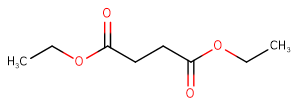
Diethyl succinate
CAS No. 123-25-1
Diethyl succinate( —— )
Catalog No. M21381 CAS No. 123-25-1
Diethyl succinate is the diethyl ester of succinate and acts as an irritant.
Purity : >98% (HPLC)
 COA
COA
 Datasheet
Datasheet
 HNMR
HNMR
 HPLC
HPLC
 MSDS
MSDS
 Handing Instructions
Handing Instructions
| Size | Price / USD | Stock | Quantity |
| 50MG | 27 | Get Quote |


|
| 100MG | Get Quote | Get Quote |


|
| 200MG | Get Quote | Get Quote |


|
| 500MG | Get Quote | Get Quote |


|
| 1G | Get Quote | Get Quote |


|
Biological Information
-
Product NameDiethyl succinate
-
NoteResearch use only, not for human use.
-
Brief DescriptionDiethyl succinate is the diethyl ester of succinate and acts as an irritant.
-
DescriptionDiethyl succinate is the diethyl ester of succinate and acts as an irritant.
-
In Vitro——
-
In Vivo——
-
Synonyms——
-
PathwayOthers
-
TargetOther Targets
-
RecptorOthers
-
Research Area——
-
Indication——
Chemical Information
-
CAS Number123-25-1
-
Formula Weight174.19
-
Molecular FormulaC8H14O4
-
Purity>98% (HPLC)
-
SolubilityDMSO:25 mg/mL (1435.21 mM)
-
SMILESCCOC(=O)CCC(=O)OCC
-
Chemical Name——
Shipping & Storage Information
-
Storage(-20℃)
-
ShippingWith Ice Pack
-
Stability≥ 2 years
Reference
1.Zacharias NM et al. Real-time molecular imaging of tricarboxylic acid cycle metabolism in vivo by hyperpolarized 1-(13)C diethyl succinate. J Am Chem Soc. 2012 Jan 18;134(2):934-43.
molnova catalog



related products
-
BMT-124110
BMT-124110 is a selective AAK1 inhibitor (IC50: 0.9 nM) with antinociceptive activity. BMT-090605 inhibited BMP-2 induced protein kinase BIKE with IC50 of 17 nM.
-
Isoamyl decanoate
Isoamyl decanoate (Decanoic Acid Isoamyl Ester) has a strong rose fragrance and can be used to formulate food flavors and cosmetic flavors.
-
Chromocarbe
Chromocarb is a vascular protective agent used in the treatment of venous disorders and microvascular affections.



 Cart
Cart
 sales@molnova.com
sales@molnova.com


